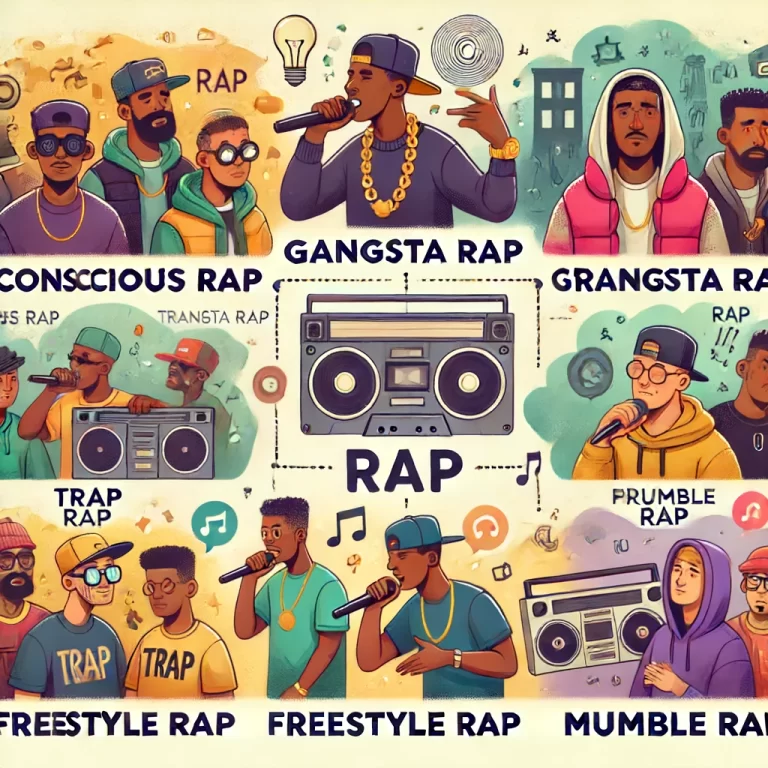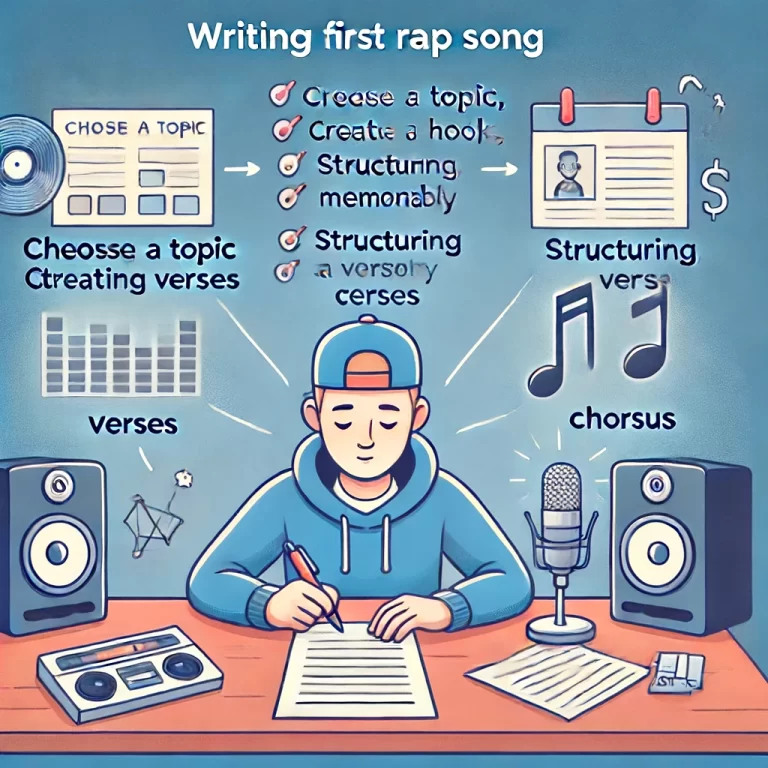How to Rap: Mastering the Art of Hip-Hop
Mastering the Art of Hip-Hop: HOW TO RAP Introduction Rap is a vital element of hip-hop culture, representing a powerful form of expression that combines

Rap is a vital element of hip-hop culture, representing a powerful form of expression that combines rhythm, poetry, and storytelling. Originating in the 1970s in the Bronx, New York, rap has grown from its grassroots beginnings to a global phenomenon, influencing music, fashion, and social movements. Whether you’re an aspiring rapper or simply curious about the craft, understanding how to rap involves mastering various techniques and styles.
Rapping isn’t just about spitting words quickly; it’s about delivering a message with impact, rhythm, and style. From the intricate wordplay of conscious rap to the high-energy vibes of trap music, each subgenre of rap offers unique elements and challenges. This comprehensive guide will take you through the history of rap, break down the different types of rap, and provide detailed steps on how to start rapping. You’ll learn about essential techniques like rhyming, flow, and delivery, as well as tips on writing your own lyrics and performing live.
Whether you’re looking to improve your freestyling skills, understand the importance of beats and instrumentals, or learn how to promote your music, this guide covers it all. Dive into the world of hip-hop and discover what it takes to master the art of rap.

Origins of Rap Music
Rap music originated in the 1970s in the Bronx, New York City, as part of the broader hip-hop culture. It started with DJs like Kool Herc who would isolate and extend percussion breaks, creating a foundation for rappers to speak over.
Evolution Over the Decades
Rap has evolved significantly over the decades, with each era bringing new styles and innovations. From the lyrical prowess of the 1980s to the gangsta rap of the 1990s and the rise of trap music in the 2000s, rap continues to diversify and grow.
Influence of Pioneers in the Industry
Pioneers like Grandmaster Flash, Run-DMC, Tupac Shakur, and The Notorious B.I.G. have left a lasting impact on the genre, influencing countless artists and shaping the direction of rap music.

Definition and Key Elements
Rap is a musical form that involves rhythmic and rhyming speech. Key elements include beats, flow, delivery, and lyrical content. The beat provides the foundation, while flow and delivery determine how the lyrics are performed.
The Role of Rhythm and Beats
Rhythm and beats are crucial in rap. The beat sets the tempo and mood, while rhythm guides the cadence and timing of the lyrics. Understanding how to match your lyrics to the beat is essential for effective rapping.
Importance of Flow and Delivery
Flow refers to the rhythm and rhyme scheme of the lyrics, while delivery is how the lyrics are presented. Both are vital for making your rap engaging and impactful.

Conscious Rap
Conscious rap focuses on social issues, political themes, and life experiences, often aiming to educate and inspire listeners. Artists like Common and Kendrick Lamar are known for their conscious rap.
Gangsta Rap
Gangsta rap emerged in the 1980s, portraying the harsh realities of street life and inner-city struggles. N.W.A. and Ice-T are iconic figures in this genre.
Trap Music
Trap music is characterized by its use of heavy bass, snare drums, and fast hi-hats. It’s known for its energetic beats and often deals with themes of drug culture and urban life. Artists like T.I. and Gucci Mane pioneered this style.
Battle Rap
Battle rap involves rappers competing against each other in lyrical battles, often in freestyle format. The goal is to outwit and outperform the opponent with clever wordplay and insults.
Freestyle Rap
Freestyle rap is improvisational, with rappers creating lyrics on the spot without pre-written content. It’s a skill that showcases spontaneity and creativity.
Mumble Rap
Mumble rap is a subgenre where the clarity of the lyrics is less important than the rhythm and flow. Artists like Lil Uzi Vert and Future have popularized this style.

Step 1: Listen to Different Rap Genres
Explore various rap genres to understand different styles and techniques. Listening to a wide range of artists will help you find your own style and preferences.
Step 2: Study Lyrics and Rhymes
Analyze the lyrics and rhymes of your favorite rappers. Pay attention to their rhyme schemes, wordplay, and how they convey their message. This will help you learn the art of writing effective rap lyrics.
Step 3: Practice Freestyling
Freestyling is a great way to improve your rap skills. Start by improvising lyrics over a beat, focusing on staying on rhythm and maintaining a consistent flow. This practice will enhance your creativity and confidence.
Step 4: Write Your Own Lyrics
Begin writing your own rap lyrics. Start with simple themes and gradually move to more complex topics. Focus on creating strong rhymes and maintaining a consistent flow.
Step 5: Develop Your Flow and Delivery
Work on your flow and delivery by practicing your lyrics over different beats. Experiment with various rhythms and styles to find what works best for you. Record yourself to identify areas for improvement.

Choosing a Topic
Select a topic that resonates with you. It could be personal experiences, social issues, or a storytelling theme. Having a clear topic will make your lyrics more focused and impactful.
Creating a Hook
The hook is the catchy part of the song that repeats and stays in the listener’s mind. Create a memorable and engaging hook that complements the theme of your song.
Structuring Verses
Structure your verses with a clear beginning, middle, and end. Each verse should build upon the theme and progress the narrative or message of the song.
Crafting a Memorable Chorus
The chorus is the centerpiece of your song. Make it catchy and repetitive, as it’s the part listeners will remember most. Ensure it ties in with the verses and hook.

End Rhymes
End rhymes occur at the end of lines and are the most common type of rhyme in rap. They create a strong rhythmic effect and make lyrics memorable.
Internal Rhymes
Internal rhymes happen within a single line or across multiple lines. They add complexity and can make your lyrics more engaging.
Multisyllabic Rhymes
Multisyllabic rhymes involve matching multiple syllables, which adds a layer of sophistication to your lyrics. They are often used to showcase technical skill.
Slant Rhymes
Slant rhymes, or near rhymes, involve words that sound similar but aren’t exact rhymes. They allow for more flexibility and creativity in writing lyrics.
Eye Rhymes
Eye rhymes are words that look like they should rhyme because of their spelling but don’t actually rhyme when spoken. They can add a visual element to your lyrics.

Practicing Regularly
Consistency is key to improving your rap skills. Practice rapping daily, working on different aspects like writing, freestyling, and delivery.
Recording and Reviewing Your Performances
Record your raps and listen to them critically. Identify areas where you can improve, such as clarity, rhythm, and emotion in your delivery.
Seeking Feedback and Collaborating
Seek feedback from other rappers, friends, or mentors. Collaborating with other artists can also expose you to new techniques and styles.
Studying Successful Rappers
Analyze the work of successful rappers to understand what makes them stand out. Study their lyrics, flow, and performance style to learn from their success.

Finding the Right Beat
The beat sets the tone for your rap. Experiment with different beats to find one that complements your style and enhances your lyrics.
Working with Producers
Collaborating with producers can help you create high-quality tracks. A good producer can provide beats that match your vision and elevate your music.
Beat-Making Basics
If you’re interested in creating your own beats, learn the basics of beat-making. This includes understanding rhythm, sampling, and using beat-making software.
Rapping is an art that requires dedication, practice, and a deep understanding of rhythm and poetry. By mastering the basics, experimenting with different styles, and continuously honing your skills, you can become a proficient rapper. Remember, the journey is just as important as the destination, so enjoy the process and keep pushing your creative boundaries.
What is the most important aspect of rapping?
How can I improve my freestyle rap skills?
What equipment do I need to start recording rap music?
How do I find my unique style as a rapper?
Can anyone learn to rap, or do you need natural talent?
Mastering the Art of Hip-Hop: HOW TO RAP Introduction Rap is a vital element of hip-hop culture, representing a powerful form of expression that combines
From Beats to Hits How To Make Beats That Sell in 2024 introduction In the fast-paced world of music production, beats are more than just
Beats, Bars, Brands, and Business The Rap Game Playbook Level Up Your Rap Game: Make Beats, Spit Fire, Look Fresh, and Get Paid As a
Katt Williams Spills the Tea! Katt Williams Dropping Truth Bombs: Diddy, Dating Debacles, and Dishing the Dirt! Hold onto your mic stands, hip-hop fam, because
HOW TO GET FAMOUS IN HIPHOP INDUSTRY Rappers Can Now Download Instrumental Beats You must first register and login to download beats. Log In Here
Matthew Perry cause of death Matthew Perry cause of death Matthew Perry’s death and the impact of addiction Rappers Can Now Download Instrumental Beats You
There was a problem reporting this post.
Please confirm you want to block this member.
You will no longer be able to:
Please note: This action will also remove this member from your connections and send a report to the site admin. Please allow a few minutes for this process to complete.

Responses